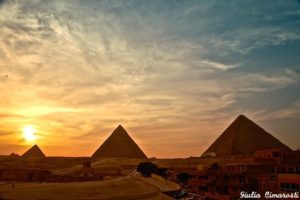
Egypt is the oldest tourist destination on earth. Ancient Greeks and Romans started the trend, coming to goggle at the cyclopean scale of the Pyramids and the Colossi of Thebes. During colonial times, Napoleon and the British looted Egypt’s treasures to fill their national museums, sparking off a trickle of Grand Tourists that eventually became a flood of travellers, taken on Nile cruises and Egyptological lectures by the enterprising Thomas Cook.
This stark duality between fertility and desolation is fundamental to Egypt’s character and has shaped its development since prehistoric times, imparting continuity to diverse cultures and peoples over seven millennia.
The land itself is a freak of nature, its lifeblood the River Nile. From the Sudanese border to the shores of the Mediterranean, the Nile Valley and its Delta are flanked by arid wastes, the latter as empty as the former are teeming with people. This stark duality between fertility and desolation is fundamental to Egypt’s character and has shaped its development since prehistoric times, imparting continuity to diverse cultures and peoples over seven millennia. It is a sense of permanence and timelessness that is buttressed by religion, which pervades every aspect of life. Although the pagan cults of ancient Egypt are as moribund as its legacy of mummies and temples, their ancient fertility rites and processions of boats still hold their place in the celebrations of Islam and Christianity.
Below are some of the famous Egyptian wonders:
CAIRO, EGYPT
Cairo’s an ancient city that also happens to be a modern metropolis—it’s one of the biggest cities in the Middle East and has the traffic and noise issues to prove it. But as long as you’re not looking for solitude, Cairo—the City of the Thousand Minarets—is a splendid place to explore Egyptian history and culture.
The Pyramid of Giza
The most famous of the structures at Giza, near Cairo, the Pyramid of King Cheops was built around 2650 BC from 2.5 million blocks of limestone. Its sides are oriented exactly to the north, south, east and west. The Chephren pyramid, built by Cheops’ son, is similar in size and incorporates the entrances to a burial chamber which still contains the large granite sarcophagus of King Chephren. The pyramid of Mycerinus is smaller than both and all three are surrounded by other smaller pyramids and dozens of tombs.
The Sphinx, Cairo
This colossal temple is on the way down to Egypt’s Valley Temple of King Chefren. The body of a lion with a human head is a 70 meters long and 20 meters high — as tall as a six-story apartment block. Although the Sphinx has been thought of as female, many scholars believe the face is that of King Chefren.
Wonders of the Nile, Egypt
Egypt has been called the gift of the Nile, for without the river it could not exist as a fertile, populous country, let alone have sustained a great civilisation five thousand years ago. A cruise down the Egyptian Nile, ideally on a romantic felucca rather than a crowded tourist boat, reveals relics of one of the world’s most ancient civilisations. The highpoint is the Valley of the Kings, with its monumental statues, and the magnificent Kom Ombo Temple, north of Aswan on the east bank.
